Our Perspective: Minnesota’s Days of Cheaper Electricity Seem Numbered
This weekend, Mike Hughlett of the Star Tribune wrote an excellent article entitled “Minnesota’s Days of Cheaper Electricity Seem Numbered,” which details how Minnesota electricity prices have increased substantially in the last 15 years. The piece is an important acknowledgement that the energy policies pursued in Minnesota are causing electricity costs to rise, an argument Center of the American Experiment has been making since late 2017.
I have included portions of the article below and added additional commentary to provide more context to help readers understand the topic in a more comprehensive manner. The article begins below:
“Hefty rate hikes that Minnesota’s largest utilities are seeking could push the state’s electricity prices above the national average for the first time in years.
Residential prices in Minnesota have been more expensive than for the nation as a whole since 2016, federal data show. With businesses included, the state’s total power price last year almost hit the national average.”
Residential electricity rates in Minnesota vary widely by electric company. The graph below utilizes data from the U.S. Energy Information Administration (EIA) and shows how the proposed rate increases will affect electric rates for each of Minnesota’s three investor owned utilities -Xcel Energy, Minnesota Power, Otter Tail Power- and compares these rates to the national average.
The data show residential electricity rates for Xcel Energy have been higher than the national average since 2015, and this difference is likely to grow based on the proposed rate increases. Residential rates for Minnesota Power customers will remain below the national average after their proposed rate increases, and residential electricity rates for Otter Tail Power are projected to remain well below the national average.
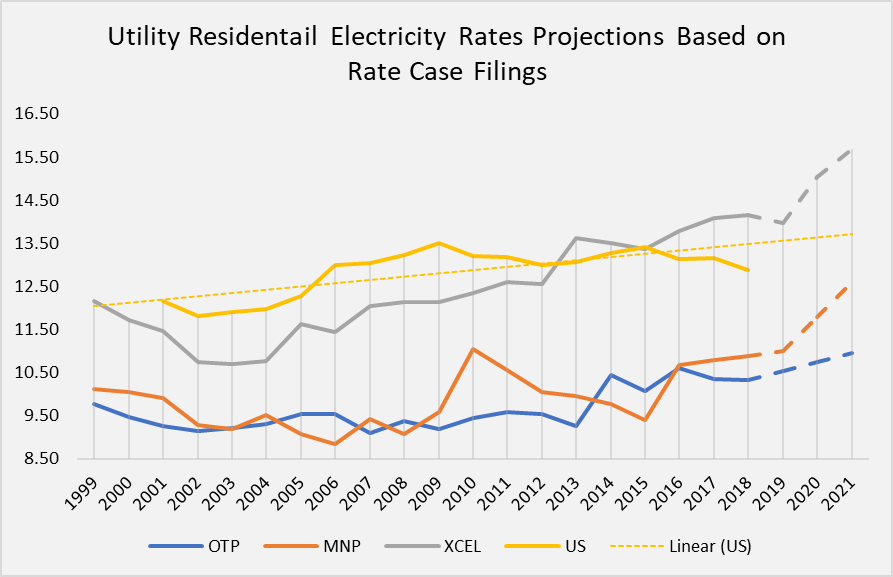
These price increases will have important implications for the budgets for Minnesota families.
“Then earlier this month, Minnesota’s two largest electric utilities — Xcel Energy and Minnesota Power — asked state regulators for significant rate hikes. Xcel filed for a 15% increase over three years, which would leave residential customers paying an estimated $110 more per year by 2022.”
On average, Xcel Energy is increasing rates by 15 percent. This figure is an average increase, with commercial ratepayers experiencing at 13.5 percent increase in costs, and residential customers experiencing a 17.75 percent increase in electricity prices. This has important implications because Xcel Energy has been reporting that the increase in costs will be $110 per household per year.
As I wrote about last week, the $110 per year figure is predicated on an assumed 10 percent reduction in electricity consumption between 2018 and 2022. However, if electricity consumption remains constant at 2018 levels, the average residential electricity customer will pay nearly $200 more per year, as you can see in the table below.

The article continues:
“Any time prices go up, we are concerned,” said Steve Kelley, commissioner of the Minnesota Department of Commerce, which is charged with looking out for consumers in rate cases before state regulators.”
It is very encouraging to see that Commissioner Kelley is concerned about the rise in electricity rates, and hopefully this concern begins to translate into policy changes at the Department of Commerce. For example. the Department of Commerce has been one of the largest advocates of the community solar program, which Xcel Energy estimates will increase customer bills by $39 per year.
Additionally, Commissioner Kelley testified in favor of the proposed 100 percent carbon free electricity mandate during the last legislative session. If enacted, this policy would result in more capital investment, which is the largest factor behind the current rate increases, and ultimately drive even larger increases in electricity rates in the future. If Commissioner Kelley is truly concerned about rising electricity rates, he cannot continue to support the policies that are causing them to rise in the first place.
“Electricity is one of the most basic expenses for households and businesses — and rising electricity prices have become a growing issue in recent years for Minnesota businesses, said Lauryn Schothorst, a public policy analyst at the Minnesota Chamber of Commerce.
“When cost competitiveness starts to change — and the state becomes less competitive — we take notice,” she said.
The cost increases are in large part because investments by Minnesota utilities — with the blessing of state regulators — are surging at a rate not seen since the 1970s and early 1980s, industry executives and industry analysts said.
In 1970s and 1980s, utilities were accused of artificially inflating their capital spending beyond what was needed to increase their guaranteed rates of return. Remember, because utility companies are government-approved monopolies, they make a guaranteed profit each time they spend money on capital projects like power plants-whether they be powered by coal, nuclear, natural gas, wind or solar-along with transmission lines, and even their corporate offices.
The article continues to elaborate on why capital expenditures are occurring:
“Over the past decade, over $2 billion has been sunk into new transmission projects, reinforcing the reliability of Minnesota’s power grid with hundreds of miles of new power lines. And with environmental concerns mounting, the investment in wind farms is now counted in billions of dollars.
Xcel Energy, by far the state’s largest electricity provider with 1.3 million customers, has spent $1 billion converting coal-fired plants to natural gas. And the company has invested $2 billion in its Minnesota nuclear plants.”
Spending on coal, natural gas, and nuclear plants in recent years has been substantial. The costs of retrofitting and upgrading the Monticello and Prairie Island nuclear plants, and various upgrades and conversions at Big Stone, Sherco Becker (2 plants), Allen S. King, Riverside, Black Dog, and all MN Power Facilities—which includes the Clay Boswell power plant— amounted to approximately $4.5 billion over the past decade.
While these investments have been substantial, they are far lower than the investments in wind turbines and transmission lines in our state. Center of the American Experiment’s 2017 report Energy Policy in Minnesota: The High Cost of Failure discovered that more than $15 billion has been spent on wind turbines and transmission lines since 2007.
Since then, hundreds of millions more have been invested in wind turbines and solar panels, which continues to put upward pressure on electricity rates.
A history of conservation
Minnesota once enjoyed a comfortable discount on electricity compared with the nation as a whole, but that gap has been steadily narrowing.
However, in Minnesota, the residential electricity price grew by an annual average of 3.6% from 2002 through 2018, a Star Tribune analysis of U.S. Department of Energy data shows.
In the same period, U.S. residential power prices on average grew 2.7% annually, while the annual U.S. inflation rate averaged 2.1%.
“Anytime time you see rate increases, it is going to be difficult for some people in Minnesota to pay their bills,” said Annie Levenson-Falk, executive director of the Citizens Utility Board of Minnesota, a nonprofit ratepayer watchdog group. Lower-income consumers and people on a fixed income — often seniors — usually face the most difficulty as higher power costs eat up a greater proportion of their budget.
However, Minnesota residential electricity consumption in 2018 was about 15% below the national average, the federal data show, so the actual monthly bills sent to households are still on average below the norm.
It is true that electricity consumption in Minnesota is below the national average, but this figure requires more context to explain why this is the case.
The graphs below use EIA data to show 2017 electricity consumption, electric bills, and natural gas consumption in twelve states: Indiana, Illinois, Iowa, Kansas, Michigan, Minnesota, Missouri, Nebraska, North Dakota, Ohio, South Dakota, and Wisconsin. On average, Minnesota residential customers used less electricity than households in all but three states: Michigan, Wisconsin, and Illinois.
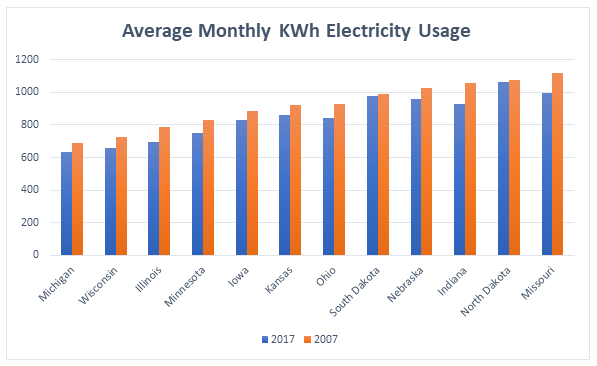
Lower electricity consumption in these states can be attributed to higher consumption of natural gas for home heating, resulting in lower electric bills. The graph below shows that Michigan and Illinois use natural gas to heat their homes to a greater extent than Minnesota, and 65 percent of households in Wisconsin are heated with natural gas, compared to 66 percent in Minnesota.
You will also see that the states with the highest electricity consumption have fewer households that heat their homes with natural gas, and many of these states also have higher temperatures than Minnesota, which increases their electricity demand for air conditioning. Mitch and I have written more about this subject here.
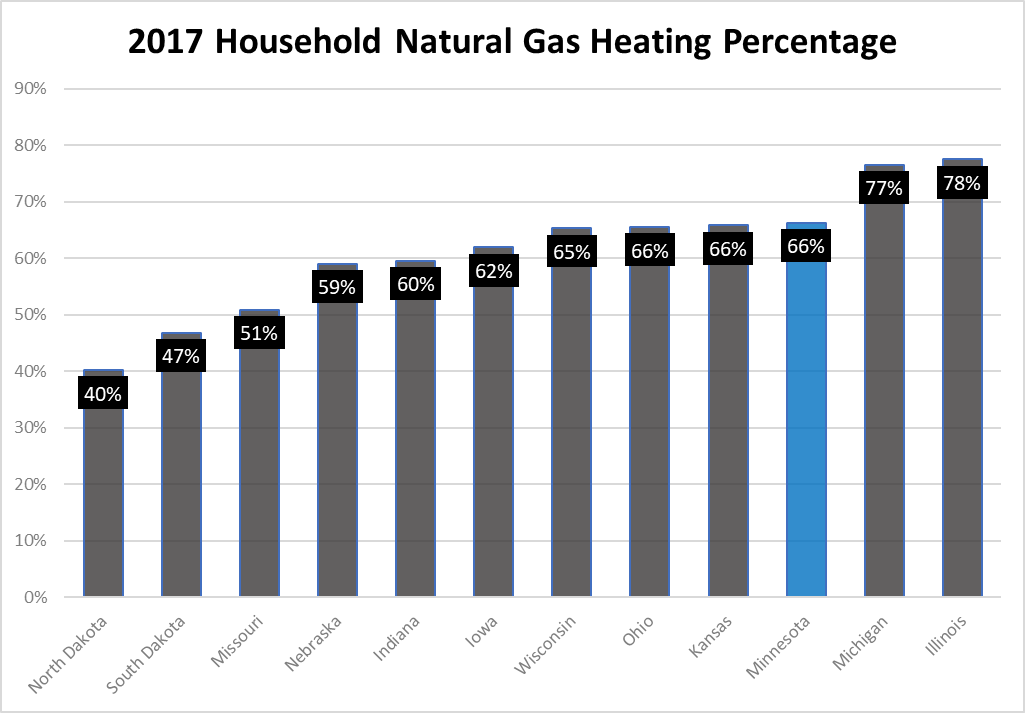
These graphs make a strong argument that Minnesota’s lower electric bills are a simply product of lower electricity consumption due to differences in natural gas and electricity use for home heating.

Because more homes use electricity for home heating in states with higher electric bills, it is problematic to compare residential electric bills in Minnesota with those in Missouri or North Dakota, for example. A more appropriate way to compare energy expenses between Minnesota and Missouri would be to combine the costs families incur on their electric bills and natural gas bills, and compare those to electric bills in areas of the country that use electricity as their primary heating fuel.
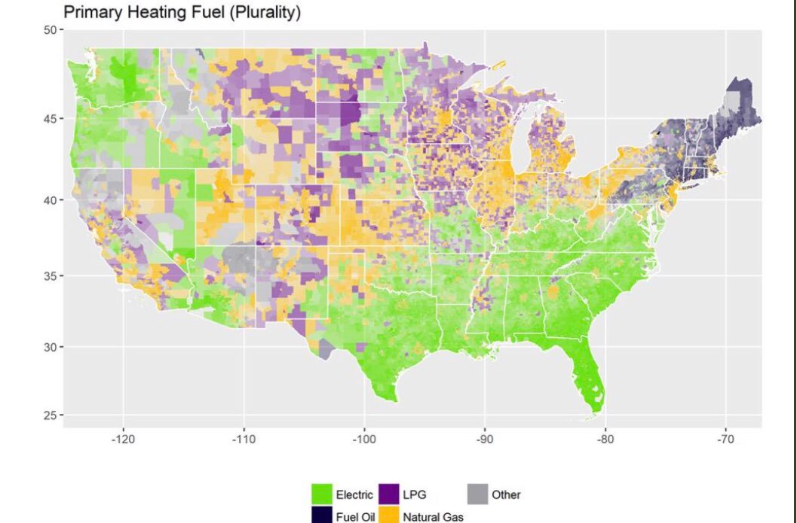
While low electricity consumption relative to other states is driven by higher natural gas use, energy efficiency has played a role in reducing electricity consumption, as the Star Tribune article notes:
“Minnesotans have a long history of investing in conservation and efficiency,” Kelley said.
The state has had conservation programs for utilities dating back to the 1980s. Energy legislation in 2007 required Minnesota electric utilities to invest 1.5% of their average annual retail sales in conservation improvements, a program essentially funded by ratepayers.
Minnesota ranks eighth in the most recent state “energy efficiency scorecard” done by the nonprofit American Council for an Energy-Efficient Economy and has been in the group’s top 10 for 12 of the last 13 years.
That lower-per-household power consumption helps cushion the blow of the higher rates. However, the gap between the national average residential bill and those in Minnesota has narrowed in recent years, beginning to follow the pattern with prices. In 2018, the average monthly U.S. residential bill was $117.65 compared to $103.34 in Minnesota, federal data show.
It is very encouraging to see the Star Tribune publish a graphic showing that Minnesota electric bills reached a new all-time high in 2018. Mitch Rolling and I have been making this point since June, but I am hopeful the Star Tribune’s graphic will bring this fact to a broader audience. It is also important to realize that bills have increased despite falling consumption.
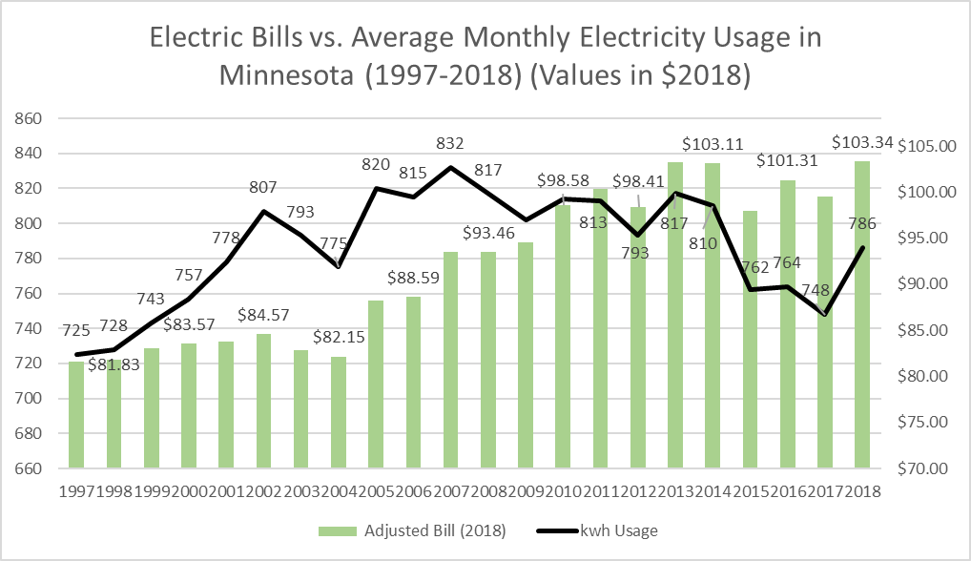
Capital spending on the rise
Rate increases are critical for utility profits, particularly as electricity sales — in volume — stagnate due to flat consumption. Rate increases in turn pivot primarily on capital spending.
Minnesota utilities have been pouring money into transmission projects over the past decade. Xcel and Minnesota Power were among 11 utilities that spent $2 billion on CapX2020, one of largest regional transmission projects since the 1970s. Including its portion of the CapX2020 project, Xcel said it has spent about $2.4 billion on transmission projects.
“CapX2020 gave us a strong backbone for the reliability of the system,” said Christopher Clark, Xcel’s president for Minnesota and the Dakotas.
Bolstering grid reliability has been a big concern since the widespread East Coast blackout of 2003, an epic failure for utilities. In the Upper Midwest, the growth of wind power has also prompted investment in new transmission because wind farms are often far away from the hubs of electricity demand.
The biggest wind energy investments are directly in wind farms, which have long been subsidized by federal tax credits aimed at fostering clean energy. Wind power generation more than tripled in Minnesota from 2007 through 2018.
Xcel alone has invested $1.4 billion in the Upper Midwest wind farms it owns, and it’s putting another $2 billion into several more that are under construction. In addition, Xcel buys power under long-term purchase deals from other wind farms.
Minnesota now gets around 20% of its electricity from wind, ranking in the top 10 wind power-producing states for several years. A 2007 state law set out aggressive clean energy goals for utilities, and they’ve been mostly met with wind power.
Some academic studies have concluded that such state renewable energy standards have added to electricity costs. Still, wind power in the past few years has become a cheap source of power; its costs have come down with technology and economies of scale.
Wind power costs have been declining in recent years, but according to Bloomberg New Energy Finance (BNEF), it is still more expensive to generate electricity from unsubsidized wind than at Minnesota’s existing coal plants, according to data from the Federal Energy Regulatory Commission (FERC).

It is also important to remember that because wind turbines only produce energy when the wind is blowing, there must be enough coal or natural gas capacity on the grid to ensure the lights stay on at all times. As a result, wind represents an additional cost to the grid. This duplication in capacity results in higher electricity prices.
One of the most important parts of the story is the fact that Christopher Clark, Xcel’s president for Minnesota and the Dakotas admitted that wind investments are a causing prices to rise:
Clark said Xcel’s wind investment has contributed to the shrinking gap between electricity prices in Minnesota and the nation as whole. But several other “wise investments” over the past decade have had the same effect, he said.
That includes about $2 billion in nuclear spending, including projects aimed at lowering operating costs and keeping Xcel’s plants safe into the 2030s, when their federal licenses expire.
“The investment in nuclear will continue to allow a substantial part of our electricity generation mix to be carbon free,” Clark said. Xcel has set aggressive carbon-free energy goals, and the company said its nuclear plants — which provide 30% of Xcel’s electricity in Minnesota — play a critical role.
Xcel and Minnesota Power — the latter increasing its spending on wind and hydro power — also have made large investments over the last decade on pollution control equipment for their coal plants.
Said Frank Frederickson, Minnesota Power’s vice president of customer experience: “It’s been a decade of investments based on what the societal expectations are for utilities.”
The next decade portends more big projects, which could mean billions of dollars in further spending and more rate increases.
Both Xcel and Minnesota Power plan to build new natural gas plants, each with price tags of at least $700 million. Xcel will likely spend many millions of dollars on new solar farms. And the region’s utilities are studying more transmission investments: The new lines built under CapX2020 are almost fully subscribed, they say.
Correction: A previous version of this article expressed commercial and industrial electricity rates per kilowatt hours in dollars instead of cents.
In its latest Integrated Resource Plan, Xcel Energy proposed building up to 4,000 megawatts of solar between 2020 and 2034. Building this much solar would cost approximately $7.5 billion, before federal tax incentives, according to 2019 cost estimates from EIA. Furthermore, preliminary cost estimates for new transmission upgrades for the CapX2050 plan are $12 billion in Region 1 of the Midcontinent Independent Systems Operator (MISO) system, which includes most of Minnesota, North Dakota, and Wisconsin. As a result, building solar and more transmission lines would require massive capital expenditures that would cause electricity rates to increase to a larger extent in the future.
This article represents an important first step in making sure Minnesota policymakers understand the consequences of their policy decisions, and I am very encouraged that the claims Center of the American Experiment has been making about how renewable energy sources impact the cost of electricity are being validated in mainstream media outlets.

